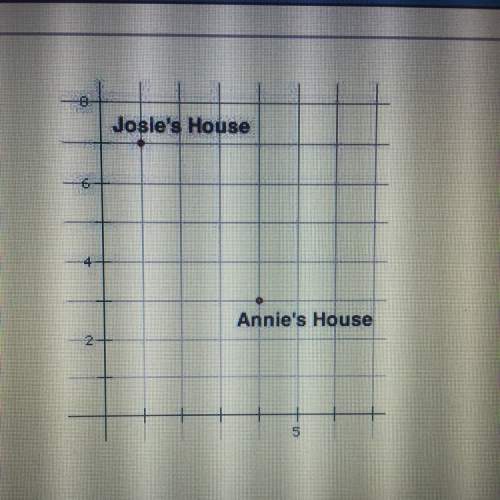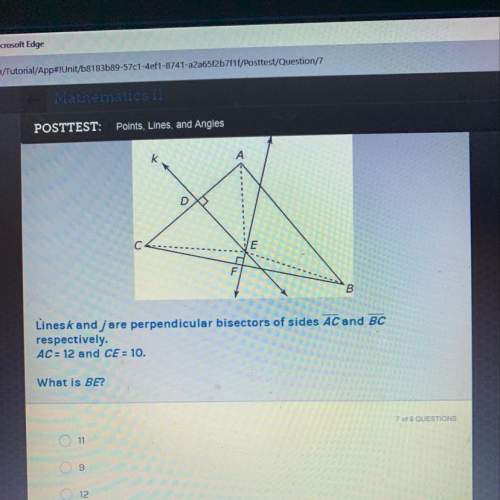1.
Determine whether the graph is the graph of a function. (1 point)
A coordinate axis i...

Mathematics, 03.03.2020 04:20, culturedxnat
1.
Determine whether the graph is the graph of a function. (1 point)
A coordinate axis is drawn with an exponential curve crossing the y axis at one increasing towards infinity.
Yes
No
2.
Determine the domain of the function. (1 point)
f as a function of x is equal to four divided by x squared.
x ≥ 0
All real numbers except 0
All real numbers except 3
All real numbers
3.
Find the range of the function.
f(x) = (x - 2)2 + 2 (1 point)
All real numbers
y ≥ 0
y < 2
y ≥ 2
4.
Determine the domain of the function. (1 point)
f as a function of x is equal to the square root of seven plus x.
x ≥ 0
All real numbers
x ≥ -7
x > 0
5.
Determine the intervals on which the function is increasing, decreasing, and constant. (1 point)
A cube root graph is shown crossing the y axis at -5.
Increasing on x < 0; Decreasing on x > 0
Increasing on x > 0; Decreasing on x < 0
Increasing on all real numbers
Decreasing on all real numbers
6.
Estimate graphically the local maximum and local minimum of f(x) = 4x2 + 3x + 2. (1 point)
Local maximum: (-0.4,1.44); local minimum: (0,-0.37)
Local maximum: (-0.4,1.44); no local minimum
No local maximum; local minimum: (-0.4,1.44)
No local maximum; local minimum: (0,-0.37)
7.
Determine if the following function is even, odd, or neither.
f(x) = -9x4 + 5x + 3 (1 point)
Odd
Even
Neither
8.
f(x) = 3x + 6, g(x) = 2x2
Find (fg)(x). (1 point)
2x2 + 3x + 6
6x + 12
6x2 + 12x
6x3 + 12x2
9.
f(x) = Square root of quantity three x plus seven. , g(x) = Square root of quantity three x minus seven.
Find (f + g)(x). (1 point)
Square root of six x.
x Square root of six.
3x
Square root of quantity three x plus seven. + Square root of quantity three x minus seven.
10.
f(x) = x2 + 3; g(x) = Square root of quantity x minus two.
Find f(g(x)). (1 point)
f(g(x)) = (x2 + 3)( Square root of quantity x minus two. )
f(g(x)) = Square root of quantity x minus two divided by quantity x squared plus three.
f(g(x)) = x + 1
f(g(x)) = Square root of quantity x squared plus three.
11.
Find f(x) and g(x) so that the function can be described as y = f(g(x)). (1 point)
y = Four divided by x squared. + 9
f(x) = x + 9, g(x) = Four divided by x squared.
f(x) = x, g(x) = Four divided by x. + 9
f(x) = One divided by x. , g(x) = Four divided by x. + 9
f(x) = Four divided by x squared. , g(x) = 9
12.
Find the inverse of the function.
f(x) = 3x - 2 (1 point)
f-1(x) = Quantity x plus two divided by three.
f-1(x) = x divided by three + 2
f-1(x) = Quantity x minus two divided by three.
Not a one-to-one function
13.
Find the inverse of the function.
f(x) = x3 + 4 (1 point)
f-1(x) = -4 Cube root of x.
f-1(x) = Cube root of quantity x minus four.
f-1(x) = Cube root of quantity x plus four.
Not a one-to-one function
14.
Find the inverse of the function.
f(x) = 6x3 - 3 (1 point)
f-1(x) = Cube root of quantity x minus three divided by six.
f-1(x) = Cube root of quantity x plus three divided by six.
f-1(x) = Cube root of quantity x divided by six. + 3
Not a one-to-one function
15.
Determine if the function is one-to-one. (1 point)
A graph is shown of two curves increasing connecting at the point 0, 1.
Yes
No
16.
Describe how the graph of y= x2 can be transformed to the graph of the given equation. (1 point)
y = x2 - 14
Shift the graph of y = x2 right 14 units.
Shift the graph of y = x2 up 14 units.
Shift the graph of y = x2 left 14 units.
Shift the graph of y = x2 down 14 units.
17.
Describe how the graph of y= x2 can be transformed to the graph of the given equation. (1 point)
y = (x-14)2 - 9
Shift the graph of y = x2 down 14 units and then left 9 units.
Shift the graph of y = x2 right 14 units and then up 9 units.
Shift the graph of y = x2 right 14 units and then down 9 units.
Shift the graph of y = x2 left 14 units and then down 9 units.
18.
Describe how to transform the graph of f into the graph of g. (1 point)
f(x) = x4 and g(x) = -x4
Reflect the graph of f across the x-axis.
Shift the graph of f down 1 unit.
Reflect the graph of f across the x-axis and then reflect across the y-axis.
Reflect the graph of f across the y-axis.
19.
The transformation from f to g represents a
stretch. (1 point)
f(x) = Square root of x. and g(x) = 6 Square root of x.
Note: Use all lowercase letters in your response.
20.
Confirm that f and g are inverses by showing that f(g(x)) = x and g(f(x)) = x.(1 point)
f(x) = x3 + 4 and g(x) = Cube root of quantity x minus four.
HEL PLEASE GIVING ALL MY POINTS TO WHOEVER HELPS FIRST

Answers: 3
Other questions on the subject: Mathematics


Mathematics, 21.06.2019 18:20, sweetbri7p5v6tn
Me solve this problem, and someone clearly explain to me how to solve it.1.) use the value of the discriminant to determine if the given trinomials has 2 real solutions, 1 real solution, or no real solutions. a. x2 − 4x − 7 = 0b. 4r2 + 11r − 3 = 0c. 3m2 + 7 = 0d. t2 + 2t + 1 = 0
Answers: 1

Mathematics, 21.06.2019 21:00, candaceblanton
Helena lost her marbles. but then she found them and put them in 44 bags with mm marbles in each bag. she had 33 marbles left over that didn't fit in the bags.
Answers: 3

Mathematics, 21.06.2019 21:30, Countryqueen525
How do your peer relationships affect your overall health status? what can you do to improve your peer relationships?
Answers: 1
Do you know the correct answer?
Questions in other subjects:



English, 15.12.2020 01:10

Chemistry, 15.12.2020 01:10

History, 15.12.2020 01:10



History, 15.12.2020 01:10

Physics, 15.12.2020 01:10

Mathematics, 15.12.2020 01:10








